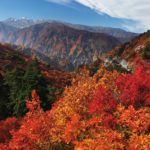 Located on the central coast of Japan’s Honshu Island, Ishikawa Prefecture is away from the tourist trail yet easily accessible by bullet train from Tokyo.
Located on the central coast of Japan’s Honshu Island, Ishikawa Prefecture is away from the tourist trail yet easily accessible by bullet train from Tokyo.
As we begin to plan where to travel when the international borders open, is it the hot springs of Kaga, the rural countryside and sea views of Noto or the historic streets of Kanazawa that call you back?
The Hashitate district is steeped in seafaring history, which today stands as a quaint fishing town filled with traditional Japanese houses and winding streets. For those interested in the area’s past and Japan’s history at sea, the Kitamaebune Ship Museum is worth a visit.
Geisha Districts:Think you need to head to Kyoto to find a geisha district? Kanazawa is home to three geiko (the local name for geisha) districts, with Higashi-Chaya District being the most significant of these. Established in 1820, many of the traditional teahouses have been transformed into cafes, restaurants, sweet shops, and craft shops that you can peruse, but some still retain their original purpose as geiko teahouses. Although the world of geiko entertainment is exclusive and access must be gained by referral, general visitors can tour some teahouses and see a geiko show.
Gold Leaf Craft: According to legend, gold leaf production began in Kanazawa when the first Maeda lord, Toshiie (1537–1599), ordered gold-tipped spears for his warriors. Since then the city has become the gold leaf capital and visitors can try their hand at gold leaf crafting souvenirs to take home at one of these specialist shops.
Samurai estates once occupied 70% of Kanazawa and several neighbourhoods still stand today. The most notable is Nagamachi Samurai District where you can tour the former family home of a Samurai warrior and wander the streets that have retained the atmosphere of 17th and 18th century Japan.
Explore the golden city by electric bike using Kanazawa’s e-bike share scheme, machi-nori. In the last month, three ports have been added, now totalling 52, making it a breeze to get around without relying on public transport.
Where to stay: Kanazawa has a place to stay for all budgets – from the personalised service with just four suites and michelin-starred restaurant at Ryokan Asadaya to panoramic views and contemporary rooms at Hotel Nikko or tea house styled Agora.
The highlights, without the crowds:
The Holy Land for Lovers: Soaring above Iida Bay in the northeastern part of the Noto Peninsula is the uninhabited Mitsukejima Island – also known as the Holy Land for Lovers. Legend has it that love can blossom if the Matchmaking Bell on the shore is rung and a wish is made. Make the effort to visit at sunrise to see the island backlit with red as the sun rises from the sea.
Japan’s answer to Fraser Island: The Chirihama Nagisa Beach Driveway is an 8km stretch of sand that is open to visitors to drive their car along and stop to search for shells. Food stalls line the beach from Spring to Autumn selling local seafood.

Learn the traditional sea salt making methods at Okunoto Salt Farm Village, the only salt field in Japan that still farms in the ‘Agehama’ style which is valued by chefs worldwide.
Rice Terrace Beauty: Still planted and harvested by hand, the Shiroyone Senmaida Rice Terraces create unusual zig-zag patterns across the sloped landscape, with the backdrop of the Sea of Japan. Changing colours depending on the season, from mid-October to mid-March, after the rice has been harvested, the terraces are illuminated at night with 25,000 solar-powered, colour-changing LED lights.
If you like to wander local farmers markets when you travel then head to the daily Wajima Morning Market. With more than 1,000 years of history and over 200 stalls, you can sample some of the region’s celebrated fresh seafood and vegetables with free grilling stations to cook your food while you’re there.
Where to stay: While in rural Japan, be sure to check in to a guest farmhouse. With just one booking at a time, Forest offers an exclusive stay with local farming, zen and craft-making experiences available, or try Flatt’s Noto, owned by Australian chef, Ben Flatt – this guesthouse is known for its Italian-style cuisine, which is included for staying guests.















